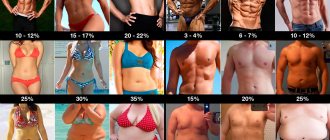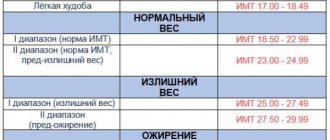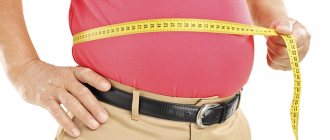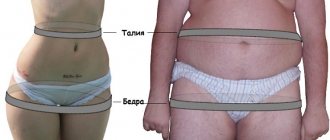- September 18, 2018
- Health
- Victoria Lovegood
To build a proper diet, you need to know not only effective exercises, but also the norm of muscle mass. This knowledge will allow you to adequately assess the state of your own body and monitor progress or degradation in training.
This norm is different for men and women. It also depends on the age, race and height of the person.
What is the normal amount of muscle mass in the human body? Let's try to figure it out.
Functions of muscle mass
Without muscle tissue, it would be impossible to smile or frown. A person would not be able to make a single movement, including breathing. He would just die.
A person cannot exist without muscles. After all, the heart also consists of muscle tissue, just like the internal organs.
Therefore, it is important to monitor your muscle mass, normalizing it and bringing it to ideal parameters. A lack of muscles depresses not only motor functions, but also the very functioning of the body.
Six reasons to maintain normal muscle mass
If it seems to you that everything is fine with your muscles, and you can forget about gymnastics, then think about how much benefit your muscles bring you.
- With a good muscular frame, you will have a “model” body. Any clothes will fit as if they were created just for you.
- If the muscle percentage is high, then your endurance and work performance will increase significantly. Down with fatigue and drowsiness!
- Having more muscle speeds up your metabolism.
- Your body will not only become stronger physically, but also improve the functioning of your immune system.
- You can't even imagine how strong you will be if your muscle mass is just above the generally accepted norm.
- A healthy and beautiful person is always confident in himself.
Well, do you want to increase the percentage of muscle mass in your body?
Fat content depending on age
For women striving for a slim and toned body, it is not possible to derive a single universal indicator of the ideal percentage of body fat. Normal body fat percentage varies depending on various factors, including age, genetics, and body type.
We suggest using one of the methods for personal calculation of the permissible amount of fat in the body. To do this, you only need scales and a calculator.
Step 1: Determine the average body fat by age
Here are typical recommendations for the percentage of body fat to total body weight, depending on the woman’s age.
20-39 years old:
- insufficient - less than 21%;
- healthy - from 21 to 33%;
- excess - from 33 to 39%;
- obesity - over 39%.
40-59 years:
- insufficient - less than 23%;
- healthy - from 23 to 35%;
- excess - from 35 to 40%;
- obesity - over 40%.
60-79 years:
- insufficient - less than 24%;
- healthy - from 25 to 36%;
- excess - from 36 to 42%;
- obesity - over 42%.
Step 2: Determining body weight size - weighing
Even the same scales often show different numbers throughout the day: depending on the time of day when you weigh yourself, the readings can fluctuate between 1-2 kg. To obtain the most correct result, weighing should be done in the morning on an empty stomach immediately after waking up.
Step 3: Calculate Body Mass Index (BMI)
BMI is calculated using a simple formula: weight divided by height squared. For example, your weight is 60 kg with a height of 170 cm. The BMI calculation for a woman with similar data will look like this: 60 kg ÷ (1.70)²= 20.76.
Step 4: Calculate Body Fat Percentage
Based on the results of scientific research based on many years of observations and the collection of statistical information, a formula was derived for calculating the ratio of fat to one’s own BMI. The formula for women is as follows:
- (1.20 x BMI) + (0.23 x Age) - 5.4 = % body fat
Let's calculate the fat ratios for the previously calculated BMI. Let's assume that a woman with a designated BMI of 20.76 is 35 years old.
- (1.20 x 20.76) + (0.23 x 35) - 5.4 = 27.562% body fat
Step 5: Analysis of the received data
Now you need to compare the result obtained with the average fat norms provided in STEP 1. Such an analysis will give you an idea of how close the obtained values are to the norm.
The body fat indicator of the woman we cited as an example was 27.562%. For her age group, the norm is 21 to 33%. Thus, she fits into the recommended indicators, but for herself she can conclude that she needs to work on her data to get closer to the lower norm. We discussed in detail above what methods to choose for this.
Methods for measuring muscle mass
If you are faced with the need to take measurements of your muscle mass, then do not worry. There are several ways by which you can find out more or less accurate percentages of muscle mass, fat and water in your body.
- Measurements in clinics and hospitals. They can be considered a standard of accuracy, since in such institutions they monitor the adjustment of instruments. There are only two disadvantages: the inconvenience of constant monitoring and the need to pay for the procedure. They are unlikely to measure you for a “thank you.”
- You can purchase so-called smart bathroom scales. The pricing policy is quite pleasant; you can find a good gadget for 1,000 rubles. Of the minuses: the accuracy will be less than during an examination in a clinic, but it is not critical. The difference will be approximately 1-2% from hospital measurements, which is quite satisfactory. To track the norm of muscle mass, such a deviation is quite acceptable.
- You can take measurements yourself through measurements and calculations. This method is quite difficult to perform without outside help and does not give accurate results, unlike the first two.
Body parameters assessment
Tanita diagnostic fat mass analyzer scales help to conduct a Wellness assessment
at home.
You will immediately find out the fat and water content in your body, as well as such important indicators of your health as:
- Body fat percentage
- Body water percentage
- Percentage of internal fat
- Bone mass
- Muscle mass
- Physical Type Assessment
- Metabolic rate and your metabolic age
The newest method used in the fat mass analyzer allows you to determine these indicators at home
.
1. Body fat percentage
The terms “obesity” and “overweight” are often perceived as synonyms, however, they are not the same thing. Weight is the total weight of the body, including bones, muscles, water, fat, etc. Overweight is a person’s body weight that exceeds what is considered normal for his height. Obesity is the excess accumulation of fat in the body, which poses a health risk. It often occurs when energy intake from food exceeds energy expenditure. Scientists have proven a direct relationship between excess fat in the body and the risk of developing diabetes and cardiovascular diseases. Excess weight is not always an indicator of obesity, since people differ from each other in body size, shape and type of build. For example, athletes may have a sharp increase in body weight compared to the norm for their height (due to muscle mass), but they cannot be considered obese because their body fat percentage is normal. At the same time, with normal weight, the fat content may be higher than established standards, which is a threat to health.
| Men | Women | |||||||
| Age | Fine | Fine | Badly | Dangerous | Fine | Fine | Badly | Dangerous |
| 18-24 | 10,8 | 14,9 | 19,0 | 23,3 | 18,2 | 22,0 | 25,0 | 29,6 |
| 25-29 | 12,8 | 16,5 | 20,3 | 24,3 | 18,9 | 22,1 | 25,4 | 29,8 |
| 30-34 | 14,5 | 18,0 | 21,5 | 25,2 | 19,7 | 22,7 | 26,4 | 30,5 |
| 36-39 | 16,1 | 19,3 | 22,6 | 26,1 | 21,0 | 24,0 | 27,7 | 31,5 |
| 40-44 | 17,5 | 20,5 | 23,6 | 26,9 | 22,6 | 25,6 | 29,3 | 32,8 |
| 45-49 | 18,6 | 21,5 | 24,5 | 27,6 | 24,3 | 27,3 | 30,9 | 34,1 |
| 50-59 | 19,8 | 22,7 | 25,6 | 28,7 | 26,6 | 29,7 | 33,1 | 36,2 |
| more than 60 | 20,2 | 23,2 | 26,2 | 29,3 | 27,4 | 30,7 | 34,0 | 37,3 |
2. Percentage of body water
Percentage of body water is the amount of fluid in the human body as a percentage of total weight. Water plays a key role in many processes in the body; it is found in every cell, tissue and organ. Maintaining an optimal balance of water in the body will avoid the risk of developing many diseases.
| Flaw | Norm | Excess | |
| Man | less than 60% | 60-65% | more than 65% |
| Woman | less than 50% | 50-55% | more than 55% |
3. Percentage of internal (visceral) fat
Visceral fat is the fat located in the abdominal cavity and surrounding the vital organs of a person.
Studies have shown that the distribution of fat in the body changes with age, especially noticeable after the onset of menopause in a woman. Increased levels of visceral fat increase the risk of diseases such as hypertension, heart disease, diabetes, etc. The Tanita Monitor measures the % of visceral fat with a range from 1 to 59. The range of 1-12 indicates that your body's visceral fat level is normal. Range 13-59 - indicates that your body has increased levels of visceral fat. Try to change your lifestyle, perhaps with the help of the Proper Breakfast program and physical activity. 4. Bone mass
The basis for measuring bone mass is the determination of the mass of minerals in the body (calcium and other substances). Research has shown that the development of muscle tissue strengthens the bones of the skeleton. This fact must be taken into account when planning your diet and physical activity so that your bones remain strong and healthy.
| Women | Men | ||
| Body weight, kg | Average | Body weight, kg | Average |
| less than 50 | 1.95 kg | less than 65 | 2.66 kg |
| 50 — 75 | 2.40 kg | 65 — 95 | 3.29 kg |
| 75 and above | 2.95 kg | 95 and above | 3.69 kg |
People suffering from osteoporosis or reduced bone strength caused by age, pregnant women, etc., should carefully monitor the condition of their bone mass. 5. Muscle mass
This function allows you to determine the mass of muscle tissue in the human body. The muscle mass indicator takes into account all the muscles of the musculoskeletal system, smooth muscles (heart and digestive system) and the water contained in these muscles. In a healthy person, the average muscle mass is 75% of the total mass (person’s weight). Muscles play an important role in the metabolic process. Muscle development requires significant energy expenditure, which is released as a result of the breakdown (burning) of fats.
6. Physical type assessment
This function takes into account the ratio of body fat and muscle mass. With increasing physical activity, the amount of fat in the body decreases, and the physical type may change: hidden obesity - 1, full - 2, dense - 3, trained - 4, normal - 5, standard muscular - 6, thin - 7, thin and muscular - 8, very muscular - 9.
7. Basal metabolic rate (BMR) / metabolic age
This option allows you to determine the number of calories needed to carry out the body's metabolic processes. This is the minimum level of energy required by your body to ensure normal functioning of the respiratory, circulatory, nervous system, liver, kidneys and other organs at rest. Your metabolic rate increases when you are active. This happens because the musculoskeletal system (40% of the body's weight), like a motor, consumes a large amount of energy. A significant part of the energy is spent on muscle work, so increasing muscle mass will also increase the PBM. The higher your BMR, the more calories you burn as you increase muscle mass, which will reduce your body fat levels. The lower the PBM level, the slower fat burning occurs, and the higher the likelihood of obesity with all the ensuing consequences. The analyzer allows you to determine to what age, on average, the value of the basal metabolic rate obtained as a result of measurements corresponds. If your BMR age is higher than your actual age, it means you need to increase your lean body mass. Thus, you improve your metabolic age indicators. A body parameters analyzer and consultant will help you create an individual weight loss program!
Normal muscle mass in women
It is quite difficult to express the muscle norm for a woman as a percentage. It will change due to age, height and race. Ideally, the percentage of muscle mass in women should be about 40. That is, if a woman weighs 60 kg, then 24 kg of this weight should be muscle. However, on average this percentage rarely exceeds 36-37.
The structural features of the female body are such that the bulk of the muscles are distributed below: the hips, legs and lower abs swing much more easily than the muscles of the arms or chest. This is due to the natural purpose of procreation.
By the way, it is precisely because of the need to accumulate energy for the child that a woman needs to make more efforts to get rid of fat reserves. The body is extremely reluctant to part with what it has accumulated, secretly awaiting the onset of hungry days. And this can only be overcome through your own perseverance and hard work on yourself.
Body fat percentage: normal for women
There is no exact number that determines the norm of body fat, since the physique and metabolism of each woman are different. But the approximate range can be determined taking into account age.
Be sure to read: Degrees of obesity by body mass index: how to determine, effective treatment methods
So, for the female sex, the norm of body fat is:
- aged 18 to 30 years – 15-23%;
- from 30 to 50 years – 20-25%;
- from 50 years and over – 22-27%.
Minimum and maximum percentage of fat in the female body
The minimum necessary fat layer is needed for the normal functioning of the body.
It composes:
- 10-12% – for women who do not play sports;
- 14-18% – for female athletes;
- 20-24% – for active and professional athletes.
The maximum amount of deposits is 31%. Anything higher is considered obesity and leads to cardiovascular disease.
You should also take into account age: up to 30 years old, girls should have at least 13% body fat, and more mature women should have at least 15% body fat, which is the minimum.
Normal percentage of fat in the female body
The normal percentage of fat mass in women should be higher. For young girls under the age of 30 it is 16-20%, for more mature ladies – 18-23%.
It is important to take into account your body type, since tall and large-boned women require more deposits than short and thin women.
Attention! Only a nutritionist can determine the individual indicators of the necessary fat layer for the full functioning of the body. The doctor will give all the necessary recommendations and advise on how to properly lose weight.
Normal lean body mass for men
Men gain weight more easily due to increased muscle mass. Thanks to testosterone, their body readily part with fat deposits and acquires the desired shape. It is much easier to meet “dry” men than women.
So, what can be considered normal muscle mass weight in men? For a man who is not too pumped up, the normal muscle mass is about 45%. With intense training, this ratio can be adjusted, making your figure leaner. It is quite possible to bring your body to 55% muscle mass, but further development will stall.
The body always acts based on its own benefit. Without support with special means and injections, no matter how much you train, you will not be able to achieve a muscle mass of 70% of your total body weight.
Pregnancy
Of course, pregnancy leads to weight gain. Research shows that the average woman gains 12.5 kg during the last third of her pregnancy. Moreover, 20% of this weight falls on adipose tissue. Progesterone levels remain high throughout pregnancy. Instead of making you feel hungry periodically, this hormone continuously stimulates your appetite for 9 months.
However, progesterone is not the actual culprit behind pregnancy weight gain. Responsibility for this process lies with fat cells, the number of which rapidly increases during infancy, puberty and pregnancy. In addition, when men and women gain weight quickly, the number of fat cells increases. However, during pregnancy, women do have a significant chance of becoming obese.
The number of fat cells produced depends on how quickly and how much weight you gain. Once formed, fat cells remain with you for the rest of your life, constantly requiring nutrition. It is for this reason that most of the fat tissue formed during pregnancy remains after the birth of the child.
Voluminous buttocks and wide, massive hips simplify the process of childbearing. The proportion of fat is usually located in the upper thighs. Many women with these qualities experience fewer problems during childbirth than women with narrow hips and flat buttocks.
Why is it important to control your muscle mass?
The percentage of muscle in the body can be very different. If a person does not engage in physical work, then his muscles become decrepit and lose their weight. As a result, motor function and overall health deteriorate.
There are at least four reasons why it is necessary to control the weight of muscle mass in the body.
- A sharp drop in the percentage of muscles in the body can be considered a warning about a “breakdown” in the body. Perhaps an incorrect diet or excessive work in the gym is to blame.
- A decrease in muscle mass under unchanged living conditions can signal a disease that is hidden in the body.
- A high percentage of muscle in the body is the key to good health and longevity. A high level is considered to be one that exceeds the generally accepted norm by about 5%.
- A decrease in muscle volume may indicate dehydration. Make sure you drink enough water daily.
Body fat percentage: normal for men
The normal indicators for men differ from women, since fat deposits in their bodies do not significantly affect the functioning of the reproductive function and hormonal system.
Age category should also be taken into account:
- from 18 to 30 years old there should be 10-18% body fat;
- from 30 to 50 years – 15-20%;
- from 50 years and older – 16-25%.
What is the minimum and maximum fat percentage
The minimum required for survival in men is 3 to 5% body fat. However, this amount is enough for the body to function, but not for a full life.
Be sure to read: How many calories are burned when walking and running: calorie burning rate per day without exercise
Increased stress on internal organs will affect health and lead to incurable diseases, including death.
The maximum rate for men is 31-32%, when obesity begins to develop. If there is even more fat in the body, treatment should be started immediately in order to avoid consequences.
Normal (healthy) body fat percentage
A healthy percentage of body fat varies from person to person, as people of the same height and weight may feel completely different. Appearance may also vary significantly. On average, normal and healthy men require 14-18%.
Important! When taking into account growth and physiological characteristics, data may differ. There is no need to lose weight just to meet the norm if a person does not feel any health problems and does not feel problems from being overweight!
How many calories should you consume?
You can try to look for the exact amount of calories you need to consume daily in different sources, or you can calculate it yourself using a proven formula:
655 + 9.6 × (weight in kg) + 1.8 × (height in cm) – 4.7 × (age in years).
For example, for Anna at the age of 45 with a height of 172 cm and a weight of 86 kg, the formula will take the following form:
655 + 9.6 x 86 + 1.8 x 172 – 4.7 x 45 = 1,578.7 calories per day.
The result does not take into account physical activity. That is, we received the amount of calories needed during normal life.
If you do additional physical education, then you need to multiply the result by:
- 1.38 with one active session per week or morning exercises daily;
- 1.55 if a person is actively engaged three to five times a week;
- 1.73 if classes are held daily.
The resulting number can be considered the basis for further calculations.
For example, if you want to lose weight, then the calorie intake should be reduced by 20%.
For the growth and development of the muscle frame, you need to know the calorie intake for gaining muscle mass. Good news for food lovers: you can eat less restrictively if you want to build muscles! You will need to consume more calories to gain and increase the percentage of muscle mass in your body. The calorie intake in this case is 15% higher than the basic one.
This is a must. Muscles need energy to grow, but where will you get it if you cut your own calories?
How to measure body fat percentage
There are at least ten ways to measure your body fat percentage. The most accurate of them - using MRI, the water displacement method, the Bod Pod plethysmographic body composition analyzer - are very accurate, but also very expensive (here you cannot do without the help of doctors and special equipment). The good news is that there is no need to spend a lot of money without special indications. There are three methods - simple and inexpensive, which will be quite enough for a beginning athlete.
Method of visual body assessment. Cost: free
A very simple way: you just need to undress and stand in front of a mirror (or better yet, take a photo of your body), and then, using special tables, find a photo of the body that is most similar to you in its structure. If you want a more objective assessment (and don’t really trust yourself), ask a friend for help, but in general, research says that most people cope with the task without outside help and get quite reliable results from such testing.
Caliper method. Cost: from 250 rubles
A caliper is a special tool for measuring body fat, similar to a caliper. All you need is to pull back the fat fold a little and measure its size. This is usually done in three places (but if you want a more accurate result, measure 4 or 7 places where fat is deposited). Men measure fat on the chest, belly and thighs, women measure fat on the triceps, the area above the pelvic bone and thighs. For greater accuracy, it is recommended to measure the same area at least twice, and then average the result. The final value of your body fat percentage can be obtained using a special table that comes with the caliper.
Method using “smart scales”. Cost: from 1500 rubles
A more expensive and technically complex gadget is “smart scales”, which allow you not only to measure weight, but also calculate the percentage of fat. They work using bioelectrical analysis technology: when you step on the scale, a weak electrical current passes through one leg, up to your pelvis, and back down through the other. Fat conducts electricity less well than water and muscle, and scales that can record electrical resistance automatically calculate the percentage of fat.
The method is very convenient, but alas, it is not very reliable, since it does not take into account many variables: in particular, the results may differ depending on how much water you drink, how long ago you ate, and when was the last time you exercised. Alternatively, measurements can be taken several times over 2-3 days and the average value calculated, but even in this case the method does not promise one hundred percent accuracy.
Norm BZHU
It is necessary to focus not only on calorie content, but also on the BJU norm. To gain muscle mass, the ratio of proteins, carbohydrates and fats may be even more important than calorie intake.
To calculate your BZHU norm, you still have to calculate the required calorie content. It will be needed to display the intake rates for fats, proteins and carbohydrates.
Calorie content of BJU:
- 4.5 kcal per 1 gram of protein;
- 4.5 kcal per 1 gram of carbohydrates;
- 9 kcal per 1 gram of fat.
To gain muscle mass, you need to adhere to the following ratio: 45% protein, 25% fat, 30% carbohydrates.
Let's calculate the norm of BZHU for Anna, already familiar to us, who decided to lose weight. She works out in the gym 3 times a week, which means her daily caloric intake is:
1,578.7 x 1.55 - 20% = 1,958 calories.
This works out to: 881.1 calories from protein, 489.5 from fat and 587.4 from carbohydrates. The obtained values must be converted into grams, for which we divide them by the calorie content of the BJU presented above. This yields approximately 196 grams of protein, 54 grams of fat and 131 grams of carbohydrates.
The BZHU for weight gain is calculated similarly. The ratio is 35-40% protein, 15-20% fat and 40-50% carbohydrates.
How is the BZHU norm calculated for weight maintenance? To do this, you need to consume approximately 1 gram of protein and 1.1 grams of fat and 4 grams of carbohydrates per 1 kilogram of weight. The BJU norm in this case is individual, so at first you will have to adjust your diet.
If you want to calculate the norm of BJU for maintaining weight according to the previous scheme, then the ratio is as follows: 25% protein, 30% fat and 45% carbohydrates.
Never exclude fats from your menu! This can be detrimental to your health!
How to find out on your own at home?
There is no exact way to find out how much fat is in the body. There are more accurate methods, there are simple methods that show this approximately.
So, how to calculate the percentage of body fat for men, women, and girls.
How to determine from a photo
Cheap and cheerful: to determine your body fat percentage, you need to find a body shape that is as similar as possible to yours:
For girls and women, an athletic physique is characterized by 14-20% body fat, good physical shape - 21-24%, average body fat - 25-31%. At the same time, a fat level below 10% is extremely dangerous for the female body and leads to the cessation of the menstrual cycle.
For men, 6-13 percent body fat means a toned, athletic physique and fairly defined abs, 14-17% means good physical shape with a small amount of fat in problem areas, 18-25% means an average level of shape, and above 25% means obesity.
On the positive side: this is the fastest, free and easiest way. To determine your body fat percentage, you need to find a body shape that is as similar to yours as possible.
On the negative side: it requires your assessment of yourself, which is not always objective. We may unconsciously “throw off” a few pounds in our minds and compare ourselves to the slimmer version in the photo. In a word, with a probability of 80% this method is a “finger in the sky.”
How to measure with a caliper
A caliper is a special device that measures the thickness of the skin-fat folds in different parts of the body. Based on the obtained figures, the percentage of subcutaneous fat is determined using special tables or formulas.
How to measure body fat with a caliper - !!only for women!!
- Back of the shoulder: The fold is taken vertically in the middle between the shoulder joint and the elbow.
- On the side: the fold is taken from the side diagonally in the middle between the lower rib and the hip bones.
- On the stomach: the fold is taken vertically at a distance of +-2.5 cm away from the navel.
How to calculate your body fat percentage using the formula:
% fat = (A-B+C) + 4.03653, where:
- A = 0.41563 x (sum of all three folds in mm),
- B = 0.00112 x (sum of all three folds in mm squared),
- C = 0.03661 x age in years.
Measurement common for women and men
We add the resulting numbers in mm and find out the percentage of subcutaneous fat using the table:
The positives: inexpensive, fast, you can do it yourself at home, fairly accurate indicators.
On the negative side: you need practice to learn how to use it correctly or someone else’s help, calculations using formulas are required.
How to calculate online
There are also many fat percentage calculators online based on different body measurements. So you can easily calculate online. For example, these:
- First Fat Percentage Calculator
- Second fat percentage calculator
On the positive side: it’s fast and doesn’t require any activity.
On the negative side: the calculation is unreliable.
How to calculate with scales and analyzer
How scales determine the amount of fat and muscle in the body: the device passes a weak current through you and calculates tissue resistance.
On the positive side: fast, suitable for regular home use.
On the negative side: the same as for bioimpedance - not always accurate indicators, since the figure can be affected by water balance (edema). High-quality scales will cost more than 10,000, but it’s better to refuse cheap ones - it’s a waste of money. When repeated measurements, fluid loss may show on the scale a decrease in the percentage of fat mass, although in fact it remained unchanged
The only way to use such scales is to track the trend - let the number lie, but what is important is its increase or decrease over time
How to Calculate Body Mass Index from Lyle MacDonald
The method is only suitable for untrained people, i.e. for beginners who have not yet started strength training. For the lucky owners of visible muscles built in the gym beyond the “norm”, this method is not suitable.
To determine your body fat percentage, you need to know your body mass index: BMI = weight in kg/height in square meters
For example: 50/(1.64*1.64)=18.5. Next, use the table in the picture and find your match:
Top products for fat burning
The main experts consider the following.
- Vegetables and greens. Thanks to fiber, they are perfectly satiating without adding extra calories.
- Egg white. An indispensable product in the difficult task of losing weight.
- Lenten bird. It can be turkey or chicken, and you need to choose the breast. Unfortunately, the rest of the meat contains too much fat, so you will have to give it up or seriously reduce its consumption to a couple of times a month.
- Citrus. Make special mention of grapefruit. Several very effective diets have been built on the constant use of this fruit.
- Celery. Its calorie content is so low that when consumed, the body expends more energy to digest it than it receives from it. Energy deficiency causes weight loss.
Top foods for muscle growth
In fact, it is large, but here we will highlight the main ones.
- Milk. Choose whole milk, it is much healthier than skim milk. Milk accelerates protein synthesis in muscles, which helps accelerate their growth.
- Cottage cheese. Casein in its composition is absorbed by the human body very slowly. Because of this, a constant amount of amino acids necessary for muscle growth is maintained in the blood.
- Eggs. The leucine they contain slows down the rate of muscle tissue breakdown.
- Beef. It contains a set of amino acids similar to human ones. For building muscle, beef is as effective as protein.
- Chicken breast. It has an effect on the body similar to beef. Most of all kinds of diets for both weight loss and weight gain include this meat.
- Chickpeas For vegetarians, chickpeas can be a complete replacement for meat dishes.
- Fish. Choose the following types: cod, salmon, tuna, trout, mackerel, chum salmon, pink salmon or mackerel. This fish contains a lot of easily digestible protein and amino acids necessary for life. It's simple: the fattier the fish, the healthier it is. And there is no need to worry about the dangers of this fat, because if you eat fish once or twice a week, it will not cause harm.
How to gain muscle mass if it is below normal?
If you have never done physical exercise or abandoned it a long time ago, then you should start immediately. You don't need any additional miracle exercise equipment to do exercises at home. To increase the percentage of muscles in the body and normalize metabolism, just three exercises are enough:
- Classic squats.
- Full rack push-ups.
- Plank position on elbows.
These general exercises, if performed daily, will allow you to tighten your skin, make your muscles more prominent and begin the fat burning process.
However, pay attention to the technique of their implementation: the slightest deviations can reduce the effectiveness of the exercise many times over, and with a low percentage of muscle mass, it can also become extremely traumatic.
Body fat percentage: female body
Less than 12% body fat is found only in women who place highly in athletic competitions, usually in bodybuilding and fitness.
With such a low percentage of fat, not only does the woman’s breast fat disappear, which is unnatural, but her periods also disappear.
A woman with such a percentage of fat becomes incapable of conceiving and bearing a fetus.
This percentage of fat is typical for women of model appearance - lingerie models.
For example, such a percentage of body fat may be the norm for a mulatto woman and a pathology for a Siberian woman.
This is the level that most women have. The curve of the hips is clearly visible, and there are small deposits of fat on the buttocks.
With such a percentage of fat, it’s time to think about diet and training, although there are many men who will accept such a woman for who she is.
Trouble and waist are growing. The hips become more than 100 cm, and the waist more than 80 or even 90 cm. The stomach begins to hang noticeably. The face and neck take on a rounded shape.
Even in clothes it is clear that this woman has a body.
The skin loses its beauty and clearly visible folds appear. The hips become noticeably wider than the shoulders: their circumference goes beyond 115 cm, and the waist - beyond 100 cm.
For example, with a height of 163 cm and a weight of 90 kg, a woman has 45 kg of dry mass and 45 kg of fat – 50% fat content.
If you are monitoring your body fat percentage, then be my friend on VKontakte/Facebook/Instagram
It consists of comparing yourself to the pictures above and determining who you are approximately similar to. A very inaccurate method.
Pull back the skin with subcutaneous fat, grab it with a caliper and find the percentage of fat corresponding to the caliper readings in the table. As a rule, calipers show a lower percentage of body fat than it actually is.
A weak electrical current is passed through the body, and then a “biometric resistance” is analyzed. As practice has shown, this method gives very inaccurate results.
Using a special device, the air displaced by the body is measured, and based on the data obtained, the mass of the body, its volume and density are calculated. This method is considered very accurate, but expensive.
Very accurate (with an error of only 1–3%), but expensive, complex and inconvenient method.
This method is considered the most accurate and consists of a complete study of body composition using x-rays. It is also a very expensive method.
Pull the iron
The photographs depict people in the age category of 25-35 years. It should be noted that the older a person gets, the greater the amount of fat contained in his body. For example, men aged 20 and 50 years old have the same percentage of body fat, but for the first (young) it will be 15%, and for the second – 20%. This is due to the tendency of fat to increase with age around organs and in muscles.







